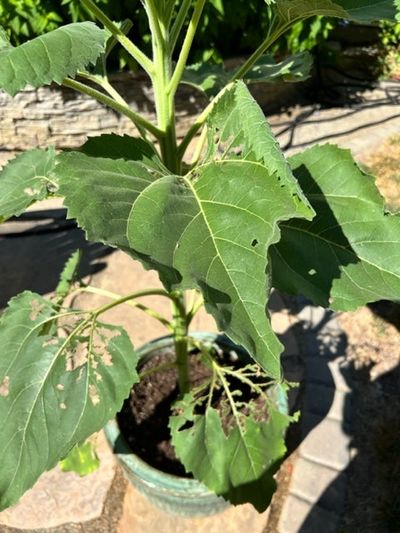Surprisingly, the leaf eater is not an insect, but probably a bird called the lesser goldfinch. While it enjoys seeds of plants in the daisy family, the lesser goldfinch also dines on sunflower foliage, leaving tattered greens in its wake.
Identify Damage from a Goldfinch on Sunflower Leaves
The range of the lesser goldfinch extends from the Western U.S. south into Mexico and as far as the Peruvian Andes in oak, cottonwood, and willow habitats. In residential areas, the lesser goldfinch visits feeders alongside American goldfinches, pine siskins and house finches. What do goldfinches eat? They primarily eat seeds of the composite family of plants and seeds of grasses, weeds, and certain trees. Lesser goldfinches add coffeeberry, elderberry, and madrone fruits to round out their diets. Experts surmise the lesser goldfinch enjoys consuming greens for the added vitamins and minerals it needs during breeding and growth phases. Sunflower leaves eaten are described as “skeletonized leaves” or “shredded leaves with angular holes.”
Control Methods
If the damage is excessive, hang reflective items such as sparkly streamers to scare them off. However, birds generally acclimate to scare tactics, so it helps to move the device every few days. Another option is bird netting stretched over the plants for protection. A commercial repellent is available that can discourage feeding. House finches have been reported to feed on low-growing vegetable plant leaves. These can be protected with row covers. Many residents just plant more sunflowers so there is enough for everyone. When considering a recourse, remember that the Migratory Bird Treaty Act makes it illegal to capture or harm protected migratory bird species without the prior approval of the U.S. Fish and Wildlife Service. This applies to bird species that are native to the United States or U.S. territories. Goldfinches and sunflowers go together like birds of a feather so don’t be surprised if they become a regular visitor to your sunflowers.
